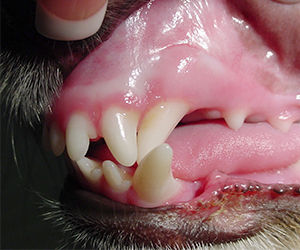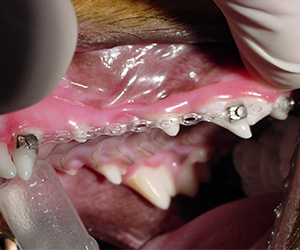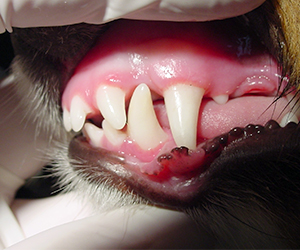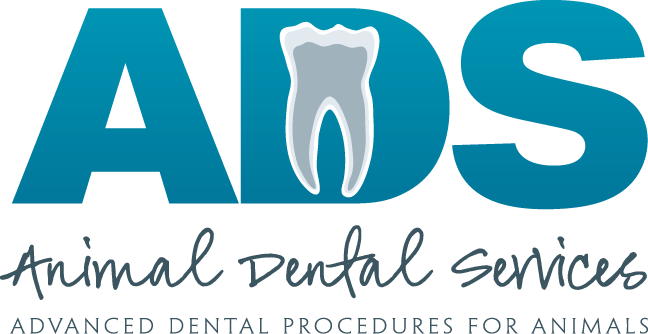Orthodontics

Misdirected tooth in a dog

Misdirected tooth having orthodontic treatment

Tooth has been moved to normal position
Just as one would seek to cure a painful skin condition, or treat a sore joint in their pet, one should also consider relieving pain brought on by orthodontic abnormalities. There are several scenarios where orthodontia can help alleviate pain and greatly improve quality of life for pets.
Poorly Aligned Teeth
Improper alignment can lead to serious periodontal disease. In most breeds, teeth are arranged in an arch. A self-cleaning mechanism occurs in this arch to push food away from the teeth and gums. If the teeth are not properly aligned, food may be trapped between the teeth, causing inflammation and even infection.
Head Shape
It is important to understand the head shape when determining normal bite relationships in various breeds. There are three basic head shapes for dogs: those with long and narrow muzzles (e.g. Rough Collie, Borzoi, Doberman, Greyhound, Saluki); those with a short and wide muzzles (e.g. Bulldog, Pug, Pekingese, Boxer, Boston Terrier, Shih Tzu); and dogs with medium length and width muzzles (e.g. Labrador Retriever, German Shepherd Dog, most spaniels, terriers, and hounds). Cats’ heads are also shaped differently and vary from the short-muzzled Persian to the longer muzzled Siamese.
Bite
The normal bite of dogs and cats with medium or long length and width muzzles is called a “scissors bite”. The upper incisors are located in front of the lower incisors when the mouth is closed, and there is a smooth curve from canine to canine without misplaced or rotated teeth. The lower canines should lie exactly between the upper lateral incisors and upper canines, yet touching neither. Premolar crown tips should point to a space between the crowns of the opposing premolars. In dogs that have a short, wide muzzle, a reverse scissors bite is considered normal; this is when the lower incisors are in front of the upper incisors. The lower canines and premolars will also be shifted forward. While the reverse scissors bite is an acceptable breed standard, at times the upper incisors cause trauma and pain to lower jaw tissues.
Occlusion
Occlusion (the contact between the teeth) is controlled by genetics, nutrition, environment, and by mechanical forces generated by the interlocking of the upper and lower teeth. Some abnormal bites (malocclusions) have been proven to be genetically influenced, such as severe over or under bites and wry bites. Other bite abnormalities have been known to be acquired (non-genetic) and these malocclusions can result from games such as tug-of-war with towels or ropes, which move teeth into abnormal positions. Traumatic birthing can also be responsible for acquired abnormalities.
Orthodontics for pets is rarely cosmetic and is nearly always a function of restoring them to optimal health.
